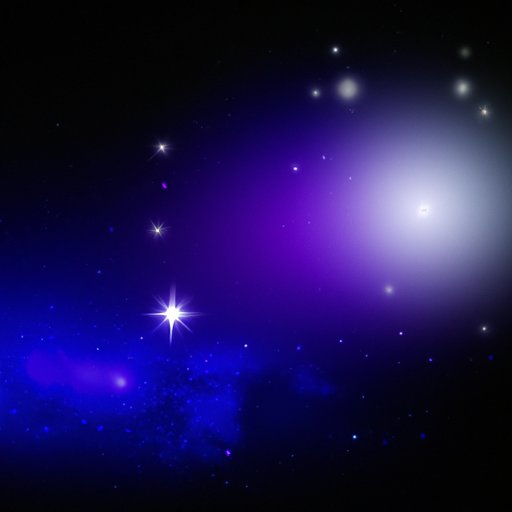Introduction
When we look up at the night sky, we are often in awe of the beautiful twinkling of the stars. However, this phenomenon can also be confusing and misleading for stargazers, who may wonder why the stars appear to flicker and change colors. In this article, we will explore the science and magic of star twinkling, from the atmospheric conditions that cause it to the ways in which it can help us better understand the mysteries of the universe.
The Science Behind the Twinkle: A Closer Look at Why Stars Glimmer in the Night Sky
Stars emit light through nuclear fusion reactions that occur in their core. This light then travels through space until it reaches Earth. However, the Earth’s atmosphere causes the light to be refracted, or bent, as it travels through different layers of air. As a result, the light can be distorted and cause stars to appear to flicker or twinkle to the human eye.
The two primary atmospheric conditions that cause this refraction are turbulence and temperature gradients. Turbulence occurs when the air in the atmosphere is unevenly heated, resulting in small pockets of different temperatures that can cause the incoming light to bounce around. Temperature gradients occur when there are large differences in temperature between different layers of the atmosphere, which can also cause the light to bend in unpredictable ways.
Overall, this refraction phenomenon is known as scintillation, and it is what causes stars to appear to twinkle.
Exploring the Twinkle Effect: The Atmospheric Causes of Star Flickering
While temperature gradients and turbulence are the primary atmospheric causes of star flickering, other environmental factors can also contribute to this effect. For example, wind can cause the light to bend as it passes through different velocities of air. Humidity can affect the refractive index of the air, which can also impact the way the light is bent. Finally, pollution in the atmosphere can scatter light and cause additional interference, which can exacerbate the twinkle effect.
In addition, different parts of the atmosphere can cause the light to refract in unique ways. For example, the troposphere, which is the lowest layer of the atmosphere, is the most turbulent, which can greatly impact star twinkle. The ionosphere, which is the outermost layer of the atmosphere, can also create refractive conditions that affect the way stars appear in the night sky.
Thanks to advances in technology, scientists have been able to better understand the atmospheric causes of star flickering over the years. Modern telescopes and imaging tools have enabled us to capture more detailed images of the night sky and the way stars behave in different atmospheric conditions.
The Magic of Star Twinkling: An Astrophysicist’s Perspective
To get a deeper understanding of star twinkle and its importance to our understanding of the universe, we spoke with Dr. Sarah Johnson, an astrophysicist and researcher at the University of California, Berkeley.
“Star flickering may seem like an annoying effect for amateur stargazers, but for scientists, it is actually incredibly valuable,” says Dr. Johnson. “By studying the way stars twinkle and behave in different atmospheric conditions, we can learn more about the properties of those stars, including their temperature, movement, and composition.”
Johnson explains that this information can be used to study other objects in deep space, such as black holes, galaxies, and supernovas. By understanding the way light behaves in the atmosphere, we can better interpret what we see when we look up at the night sky and draw new conclusions about the universe.
Twinkle, Twinkle Little Star: How Stellar Light is Bent and Refracted Before it Reaches Us
In addition to its atmospheric interactions, stellar light can also be affected by the physical properties of the universe itself. For example, gravitational fields can bend the path of light, causing interesting phenomena like the gravitational lensing effect, which can magnify or distort distant objects in space.
The curvature of space-time, which is related to Einstein’s theory of general relativity, can also affect the way light travels through the universe. This can cause a phenomenon called the gravitational redshift, which causes light waves to stretch and shift to lower frequencies as they pass through areas of strong gravitational fields.
Scientists are constantly studying these effects in order to better understand the properties of space and the universe. By analyzing how light behaves under different conditions, they can learn about the distribution of matter and energy in the cosmos, as well as gain new insights into the nature of our universe.
Seeing Stars: How Twinkling Helps Us Understand Our Universe
Overall, star twinkling is a fascinating phenomenon that both enchants and confounds us as we gaze up at the night sky. By understanding the atmospheric causes of star flickering, as well as the ways in which it can help us learn more about the universe, we can deepen our appreciation for the beauty and complexity of the cosmos.
To learn more about astronomy and explore the wonders of the night sky, check out resources like NASA’s Night Sky Network, the American Astronomical Society, or your local astronomy club.
Conclusion
We hope this article has shed some light on the science and magic of star twinkling. While there is still much we don’t know about the universe, the study of star flickering is a valuable tool that can help us unlock new discoveries and insights. Whether you are an amateur stargazer or a professional astronomer, we encourage you to continue your exploration of the night sky, and to always look up in wonder at the twinkling stars above.
